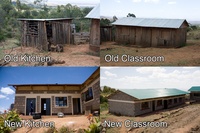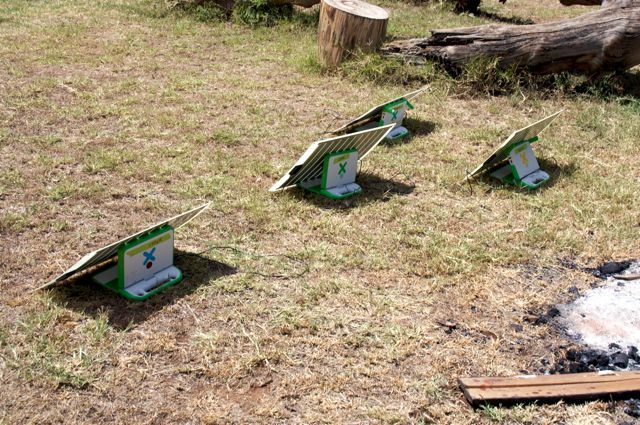
Ultimately, we were successful, but not without missteps and failures along the way. We did lots of things right, but we made a few newbie errors. Here's what we learned!
- Learn as much as you can about your destination school's physical resources.
- Don't assume that tests in the lab will duplicate conditions in the field.
- Read all the relevant blogs, forums and bulletin boards before implementing.
- Don't underestimate the sophistication of local technology and expertise at your destination.
With Kenya's abundant sunlight, the answer was to use solar power to charge the XO and CradlePoint batteries. With help of OLPC expert Mike Lee our panels of choice became the 10 watt PV Master fibreglass solar modules, these work horses were lightweight, flexible, resistant to hot, dry weather, and were able to directly plug into the XO's.
We planned to carry 8 of the panels over in a suitcase and pair each panel with an XO, allowing the students to power their laptops outside under the Kenyan sunlight. However, back in Canada, because of the cold and the lack of sunlight during our winter, we weren't able to test this system under outdoor conditions and, instead, tested our system using an array of compact florescent bulbs as a substitute for the sun; this would eventually lead to one of the problems we encountered when we arrived in Kenya.
And so, with our panels and laptops packed into our luggage, we concluded our testing on home ground and braced ourselves for a trial by fire in a world none of us had ever seen.
1) Learn as much as you can about your destination school's physical resources:
Like any live experiment, we ran into unexpected problems during the actual implementation. Our first mistake was the lack of knowledge we had about Ntugi prior to the trip; we expected wooden of classrooms since that was what Ntugi had when one of our teachers had visited four years prior to our trip.

That's why we envisioned the students working and re-charging outside in the sun. In retrospect, that was a foolish assumption. In the intervening years, Ntugi had built excellent classrooms and Kenyan weather was so hot and dry that day-to-day outdoor use proved impractical. We were forced to re-evaluate our set-up and find ways to allow for indoor use.
2) Don't assume that tests in the lab will duplicate conditions in the field:
Other than needing to accommodate indoor use, we had another problem. In our winter lab-test with light-bulbs in Toronto, we had neglected to consider two things; the Kenyan sun would alternately produce too much solar power and, of course, there would be clouds!
That meant that under peak sun, the laptops would stop charging and, when there was cloud cover, the flow of electricity from the panels to the laptops would drop precipitously. Mysteriously, this meant that we could never seem to charge the laptops beyond about 30% of their capacity and, even more mysteriously, they actually seemed to be losing their battery charge when the panels were attached. That brings me to our next newbie error!
3) Read all the relevant blogs, forums and bulletin boards before implementing:
Had we been more diligent about reading OLPC News's forums (among other sources) we would have discovered the concept of reverse polarity before we arrived in Kenya - after all, we weren't the first implementation to have this problem. Mr. Battley told us that his father used to say, "electricity flows downhill," and that's what we belatedly discovered.
Under direct sunlight, the OLPCs would charge exceptionally well however, when clouds blocked the sun intermittently, the power flow would reverse and the laptop batteries would discharging itself into the panel.

Update:
Our original diagnosis of the solar problem was incorrect. Thanks to Richard A. Smith at OLPC for the following correction:
"The input to the laptop is half-wave rectified with a diode and not subject to reverse polarity. What really happens is that, under strong sunlight, the PV panel output voltage can move into the 18-20V range. If this happens the over-voltage protection circuit of the XO-1 will disengage. It won't turn back on until the voltage falls back into the allowable range. At the time this post was 1st published these reports were just beginning to arrive. Since then this has been diagnosed, and solved.
10W Panels that are purchased for XO-1 use now have a 18V limiter on them so that the voltage will never increase above 18V. Its a $2 adder to the normal price of the PV panel. This solves the problem"
Richard was absolutely correct, and our subsequent field tests confirmed this.
Our tests in Canada had failed to account for this because we exposed the panel directly against incandescent light bulbs for testing purposes without mimicking cloud cover. This was humiliating. After all our preparation, we were tripped up by a preventable error. Had we spent a few more minutes researching online, and investing in charge controllers, we could have stopped any reverse polarity. But in our negligence, we had also disregarded looking for a local solution.
4) Don't underestimate the sophistication of local technology and expertise at your destination:
We had foolishly assumed that Kenya wouldn't have much in the way of solar technology. We figured if Ntugi hadn't used computers before, it would be unlikely that there would be sophisticated solar expertise in the local town of Meru. Thank heavens we were wrong because, with the reverse polarity problem unsolved, our implementation seemed dead in the water.
Happily, it turned out that Ntugi, with support from Safaricom and the Lewa Wildlife Conservancy already had plans for some solar power at the school.

Chloride Exide is a local company that has years of experience in solar panel installations and they came to our rescue.
Joel, their local representative, kindly helped rig a frame for our panels and helped us install a controller, battery and inverter - all for about $700 US.
We hooked up our North American OLPC chargers to a universal power bar purchased from Nakumatt (the Kenyan Wal-Mart). This solution proved to be far more practical than our original plan and allowed us to leave the panels outside to receive sunlight, while the OLPC's could be kept inside for charging and conducting classes.

Although the current set-up is not ideal because of its vulnerability to weather and theft, it has functioned beyond expectations for 8 months. Ntugi now has 20 OLPC laptops and four CradlePoint routers working with Safaricom's USB modems - all powered from our jury-rigged solar panels!
Currently, Ntugi is trying to raise $7000 to replace our current set-up with a proper series of 120 W panels from Chloride Exide that will accommodate the inevitable growth of their laptop program.
As for the four of us, this little experiment has taught us more than we could have ever expected but most importantly proven the concept of a small rural school able to leapfrog into digital age learning using renewable and self-sustainable resources.
More about our journey to come....


Hola!
Nice post!
Try going to Homepower.com and see if your school can get a CD library from them. Possibly, your school can get a free subscription, but I am not sure since you are in Canada, like US schools can receive.
Here is a copy of this month's edition.
http://www.homepower.com/files/sampleissue/HomePowerMagazine.pdf
I have over 8 yrs subscribed to their paper copy, so I know you could find many articles related to solar panels and proper battery management.
Hola!
Maybe you could write up an article for HomePower?
I think the readers would like to know more about your experiences!
Click here and find out about the free subscription.
http://www.redwoodalliance.org/librarian
Mark,
How do I contact you? I'm an engineer for OLPC and I'd like to discuss the problems you experienced with the 10W solar panels.
Some of the conclusions in this posting are incorrect. In particular the 'reverse polarity' conclusion. The power input of the XO has a half-wave rectifier which then feeds into a DC/DC converter. The only way the battery could backfeed into the PV array is if lots of stuff were blown up.
If the laptops were functional it was not reverse polarity. There are other possibilities for your problems.
you can reach me at richard at laptop dt org
Nice piece. Short and clear, and the mistakes+learning are well described, which makes it very useful for others that may want to implement a similar solution. Thank you!